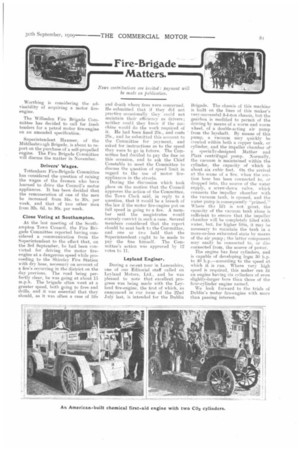Fire-Brigade Matters.
Page 15

If you've noticed an error in this article please click here to report it so we can fix it.
News contributions are invited : payment will be ;wide on publication.
Worthing is considering the advisability of acquiring a motor fireengine.
The Willesden Fire Brigade Committee has decided to call for fresh tenders for a petrol motor fire-engine on an amended specification.
Superintendent Hanmer, of the Middlesbroogh Brigade, is about to report on the purchase of a self-propelled engine. The Fire Brigade Committee will discuss the matter in November.
Drivers' Wages.
Tottenham Fire-Brigade Committee has considered the question of raising the wages of the firemen who have learned to drive the Council's motor appliances. It has been decided that the remuneration of one of the men be increased from 34s. to 39s. per week, and that of two other meet from 32s. Gd. to 36s. per week.
Close Voting at Southampton.
At the last meeting of the Southampton Town Council, the Fire Brigade Committee reported having considered a communication from the Superintendent to the effect that, on the 3rd September, he had been convicted for driving the motor fireengine at a dangerous speed while proceeding to the Shireley Fire Station with dry hose, necessary on account of a fire's occurring in the district on the day previous. The road being perfectly clear, he was going at about 15 m.p.h. The brigade often went at a greater speed, both going to fires and drills, and it was essential that they should, as it was often a case of life
and death where fires were concerned. He submitted that if they did not praetice oceasionally they could not maintain their efficiency as drivers; neither could they know if the machine would do the ‘vork required of it. He had been lined 20s., and costs 26,s., and he submitted this account to the Committee for payment, and asked for instructions as to the speed they were to go in future. The Committee had decided to pay the fine on this occasion, and to ask the Chief Constable to inset the Committee to discuss the question of speed limit in regard to the use of motor fireappliances in the streets.
During the discussion which took place on the motion that the Council approves the action of the Committee, the Town Clerk said, in reply to a question, that it would be a breach of the law if the Motor fire-engine put on full speed in going to a fire. A member said the magistrates would scarcely convict in s nal a case. Several members considered that the report should be sent back to the Committee, and one or two held that the Superintendent eught to be made to pay the fine himself. The Committee's action was approved by 12 votes to 11.
Leyland Engines.
During a recent tour in Lancashire, one of our Editorial staff called on Leyland Motors, Ltd., and he was pleased to note that excellent progress was being made with the Leyland fire-engine, the first of which, as announced in cur issue of the 22nd July last, is intended far the Dublin Brigade. The chassis of this machine is built on the lines of this maker's very-successful 3-4-ton chassis, hut the gearbox is modified to permit of the driving by means of a worm and worm wheel, of a double-acting air pump from the layshaft. By means of this pump, a vacuum may quickly be created within both a copper tank, or cylinder, and the impeller chamber of a specially-designed Mather and Platt centrifugal pomp. .Normally, the vacuum is maintained within the cylinder, the capacity of which is about six cubic feet. On the arrival at the scene of a fire, when the suction hose has been connected to, or dropped into, the source of the water supply, a screw-down valve, which connects the impeller chamber with the vacuum tank, is opened, and the water pump is consequently "primed." Where th,3 lift is not great, the capacity of the vacuum tank alone is sufficient to ensure that the impeller chamber will be completely filled with water, but, for higher lifts, it may be necessary to maintain the tank in a more-or-less exhausted state by means of the air pump; the latter component may easily be connected to, or disconnected from, the source of power.
The engine has four cylinders, and is capable of developing frgm 30 h.p. to 40 h.p.—according to the speed at which it is run. Where very high speed is required, this maker can fit an engine having -six cylinders of even slightly-larger bore than those of the four-cylinder engine named.
We look forward to the trials of Dublin's motor fire-engine with more than passing interest.






















